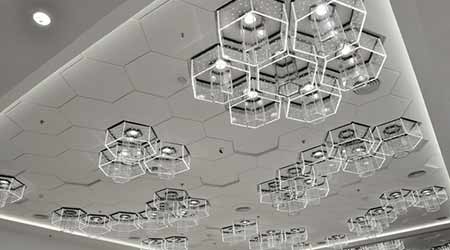LEDs Headline Updates To Lighting Products and Technology
LEDs have many advantages — energy efficiency, for instance — but keep in mind these considerations as well.
By Naomi Millán, Senior Editor
OTHER PARTS OF THIS ARTICLEPt. 1: This PagePt. 2: Lighting Products
LEDs have become common in commercial facilities for their extreme potential for energy efficiency, and new luminaires boast significant gains in lumens per watt. While inexpensive bright light has many merits in many applications, it is not the only metric when striving to provide good lighting for facility occupants. Visible light has a significant impact on human health, and LEDs in particular can unlock unprecedented access to improving occupant well-being and productivity in the built environment.
Human eyes perceive light through a variety of photoreceptors. Intrinsically photosensitive retinal ganglion cells (ipRGCs) are what link light to the circadian system, which helps to regulate sleep cycles but also affects other systems, like digestion. Providing lighting that supports the circadian system is important enough that it is the second precondition that must be achieved by facilities in the Light concept of the WELL Building Standard.
Some LED luminaires can be tuned in brightness and color temperature, which helps to better support the circadian system. Bright white light tuned toward the cooler end of the spectrum in the morning can help promote alertness, while gradually tuning this light toward the warmer end of the spectrum as the day progresses helps the body prepare to rest. This shift mimics what daylight naturally does. LED fixtures are now available that can automatically tune themselves to follow this arc. Already in some commercial applications, LEDs are tuned to specific temperatures to help speed patient healing in hospitals or quiet a room of rowdy elementary school students coming in from recess.
LED considerations
LED fixtures also have the potential to harm human health when improperly applied. One major issue is the potential for glare. That’s because the capacity for lumen output is far greater than the legacy lighting sources new LED lamps and luminaires may be replacing. Another factor is a potential for flicker. At the very least, flicker can be distracting and annoying. At the worst, it can trigger migraines and even seizures in some people.
Any light source can flicker, including incandescent, fluorescent and high-intensity discharge, usually due to the fluctuations in AC power, says a U.S. Department of Energy Solid-State Lighting Program report, “Characterizing Photometric Flicker.” Flicker had mostly gone away as an issue for facility managers once high-frequency electronic ballasts replaced magnetic ballasts. However, flicker came back as an issue with LEDs due to a mismatch with the LED driver, or the driver and dimmer pairing, according to the report.
The lighting industry has been working to address the issue of flicker in LED fixtures. Working with manufacturers whose quality facility managers trust is one step to take. As well, facility managers should verify there is full compatibility between the lighting fixture, driver, and lighting controls.
Email comments and questions to naomi.millan@tradepress.com.
Continue Reading: Lighting
 LEDs Headline Updates To Lighting Products and Technology
LEDs Headline Updates To Lighting Products and Technology
 Lighting Products
Lighting Products
Related Topics:













